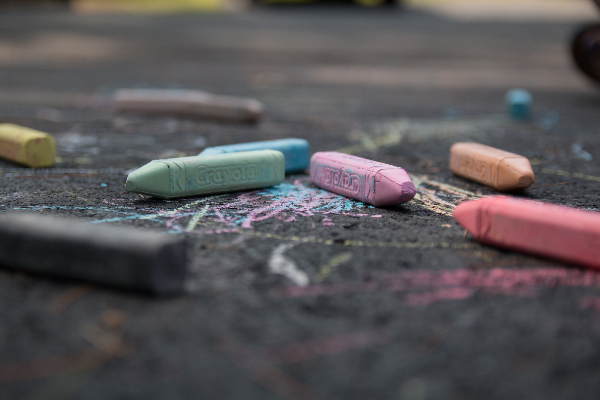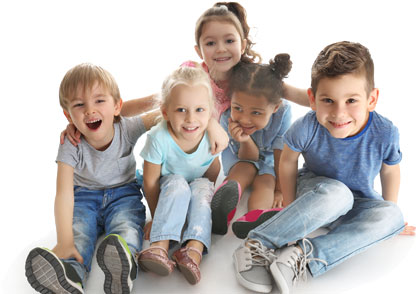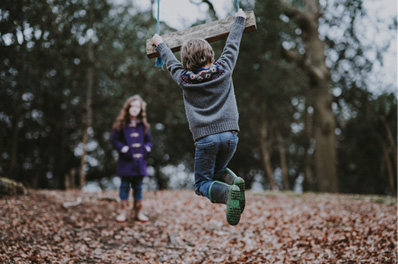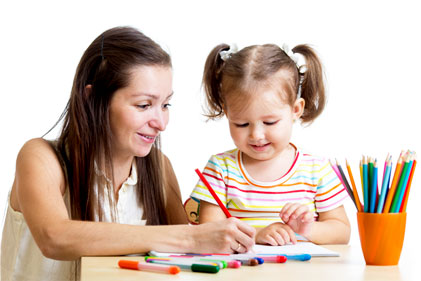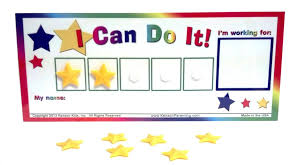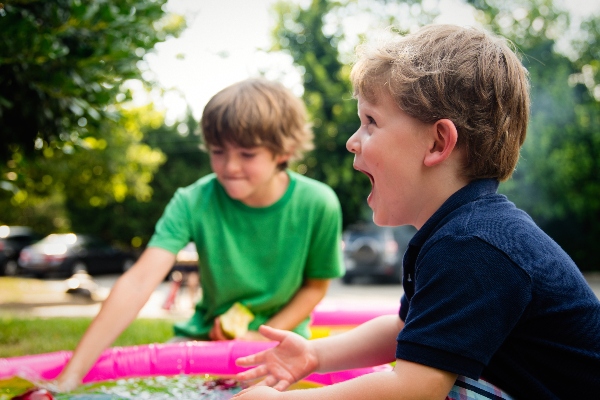Happy Summer friends and family! It’s August, it’s hot, and it’s totally acceptable to walk around wishing people a “Happy Summer.” What exactly does happy summer mean though? It is important to acknowledge that it could mean something different for everyone. Growing up when I thought of summer, a few things would come to mind – like barbecues, long days at the beach, and lots of late night trips to get ice cream. My siblings and I used to team up together and create a list of activities we wanted to do that summer. Little did we know we were making a summer bucket list!
The beauty of a bucket list is that it is so diverse and flexible. It can range from big expensive things to natural environment settings with little to no cost and everything in between! All of us at GBS created our own for this summer and made it easily modifiable to fit each and every family. We’d love for you all to use it for ideas for your own family. Check it out below!
Tye-Dye Day
What you need: tie dye colors & white t-shirts
How Can I Incorporate ABA into Tye-Dye Day?
 Following Multi-Step Directions: To do this you can say things to your child/learner such as, “Lay your clothing flat, pick out your colors, and put your gloves on.” Keep these natural and related to the activity!
Following Multi-Step Directions: To do this you can say things to your child/learner such as, “Lay your clothing flat, pick out your colors, and put your gloves on.” Keep these natural and related to the activity!
Expressive Color Identification: This is a skill we can practice with the younger children. This concept of ABA includes things like holding up a colored item, the tye-dye in this case, and asking your child “What color is this?” This will encourage and provide them opportunity to respond by stating a color- focus here is strictly on colors.
Fine Motor Skills: Fine motor skills include specific, sometimes difficult hand movements. During this activity your child will practice fine motor skills by opening up the package of dye, screwing the top of the dye on and off after adding water to the mix, twisting their shirt for fun designs, and applying rubber bands to hold the twist tight!
Fly a kite at the beach
What you need: a kite!
How Can I Incorporate ABA into Flying a Kite at the Beach?
Following Multi-Step Directions: This is a skill that can really be incorporated into any activity! For kite flying your child will be provided with written instructions to follow on the back of the kite. Or you can say things such as, “Find a secluded spot, open your kite, unroll the string.”
Self-awareness: It’s important to have self awareness when out in the community. This includes things such as being aware of how close you are to other people and how loud you are. It’s not appropriate to fly a kite right next to where someone is sitting on the beach because you most likely will have to walk with the movement of the kite and if someone is sitting there you would be invading their space. It’s also important to be aware of your volume. It’s okay to be louder than usual from excitement, but make sure this doesn’t last too long. It’s not appropriate to be yelling when lots of other people are around!
Safety: This is another skill that can be incorporated into a lot of different things. Here you’d want to practice parking lot safety with your child, “Remember we look both ways before crossing the street” also being at the beach opens the child up to more of a free and open area. You can practice with things like, “No running away from me,” or, “We don’t go by the ocean without an adult.”
Do an at home science experiment
What you need: skittles, a shallow dish or bowl, warm water or milk
How can I incorporate ABA into an at home science experiment?
 Expressive identification of items: To do this, ask your child to show you something related to the project. “Show me the scissors” or “Get the cup of water.”
Expressive identification of items: To do this, ask your child to show you something related to the project. “Show me the scissors” or “Get the cup of water.”
Following Multi-Step Directions: Depending on what science experiment your completing this skill will include having your child follow the directions of completing the experiment. You can also verbally give your child the direction if reading isn’t quite in their skill repertoire. “You need to get the water cup, scissors, and plastic bag.”
Auditory Comprehension/Listening Skills: This coincides with following directions from an adult rather than reading from a piece of paper. It’s important for your child to be attending to you when you are speaking to them to ensure they understand the expectations, experiment, and what they need to do/gather.
** For our science experiment at home we did the Skittles Rainbow Experiment! It’s super cool, easy, and cost friendly. The materials you will need are a flat plate, skittles, liquid, and a dropper. The object is to arrange the skittles into a design or pattern within the perimeter of the plate and watch the colors separate from the candy into the liquid as it creates cool swirls and lines.
How to:
Step 1: Gather all materials!
Step 2: Arrange your skittles along the perimeter of your plate. This can be done in any color order or pattern you’d like.
Step 3: Use a dropper or even a straw to drop liquid into the center of the plate. You want to do this until the liquid reaches the opposite side of your skittles (outer end of the plate). Whichever liquid you use, make sure it is warm. We found the warm liquid stripped the candy of its color quicker and the colors were more pronounced.
Step 4: Wait! It’s worth it!
Driveway/Sidewalk Chalk Art
What you need: just some chalk!
How can I incorporate ABA into outside chalk art?
Fine Motor Skills: Fine motor skills and chalk art? Thanks right, correctly grabbing and holding the chalk while drawing and opening the chalk packaging.
Receptive and Expressive color Identification: To practice this skill ask your child for specific colors of chalk- “Give me the purple chalk,” or “show me the orange chalk.” You can also hold up a color and ask your child what color chalk you have. This will allow them to identify the chalk color expressively.
Safety: Although this activity will most likely be done in the comfort of your own home, it is important that your child knows safety skills. Driveways are the most common area for chalk art and are located on the street. Go over some rules with your child such as, if the chalk rolls into the street they need to leave it there and get an adult.
Bonfire & S’mores Night
What you need: a small campfire or gas fire pit, graham crackers, chocolate bars, marshmallows, skewers
How can I incorporate ABA into a bonfire/s’mores night?
 Safety: This is important for this activity, there is literally fire involved! Provide your child with a few safety rules before getting started. You can say things like “An adult starts the fire and will tell you when it’s safe to come sit down closer.”
Safety: This is important for this activity, there is literally fire involved! Provide your child with a few safety rules before getting started. You can say things like “An adult starts the fire and will tell you when it’s safe to come sit down closer.”
Waiting: It is important your child knows they need to wait until an adult says it is time to come sit, extend their marshmallow for roasting, and removing their marshmallow off the stick for a complete s’more. There also may be a group of people making s’mores and everyone will need to wait their turn for assistance.
Attending: Due to such a risky activity, it is important your child attends to you when speaking. They need to follow all directions and rules to allow for a smooth and safe s’mores making night!
Lunch Picnic
What you need: blanket, food, drinks, utensils, basket/bag
How Can I Incorporate ABA into a Lunch Picnic?
Following Multi-Step Directions: In doing this you can provide your child with natural directions related to the activity. In this case, “lay the blanket flat, open the basket, and take out your lunch!” This can be used at the end of the picnic as well. “Stand up, open the basket, and put your materials back in to go home.”
Spacial Awareness: This is an important social skill for our learners/children to have. It’s important to teach them that the correct, and polite thing to do is sit a certain distance away from people during a picnic outing if there are several picnics going on at the same time. If you’re the only ones approaching the area for a picnic, maybe focus on staying an appropriate distance away from the walking trail, or doggie area of the park!
Safety: This one is very important when taking our population into the community. Here we want to focus on crossing the street and traveling through a parking lot. You can remind the child of “safety rules” before getting out of the car such as, “Remember we stop at the curb and look both ways before we cross the street.” Or, “We always hold hands/stay together when walking through a parking lot.”
Family or Friend Movie Night
What you need: snacks, a movie, and a tv or projector
How can I incorporate ABA into a family movie night?
 Tolerating a movie of someone else’s choice: Typically movie night is always a fan favorite however, there’s always a chance someone gets super upset because they didn’t get to choose the movie. We can remind our children that we want to be fair and everyone will get a chance to choose the movie at some point. Maybe create a schedule to allow your child to visually see when it’ll be their turn. Or you can create a jar of suggestions and choose one while closing your eyes. This shows children that all of their choices are in the jar and you are mysteriously choosing one. Their choice will get chosen eventually!
Tolerating a movie of someone else’s choice: Typically movie night is always a fan favorite however, there’s always a chance someone gets super upset because they didn’t get to choose the movie. We can remind our children that we want to be fair and everyone will get a chance to choose the movie at some point. Maybe create a schedule to allow your child to visually see when it’ll be their turn. Or you can create a jar of suggestions and choose one while closing your eyes. This shows children that all of their choices are in the jar and you are mysteriously choosing one. Their choice will get chosen eventually!
Attending to a movie: This skill is important when watching tv with others. Attending to the movie helps keep manners and teach appropriate skills while watching with others. Its not appropriate to jump on the couch, talk, or sing while a family movie night is happening!
Catch Fireflies
What you need: a glass jar with lid (be sure to poke some air holes!)
How can I incorporate ABA into catching fireflies?
Following Two step directions: Again, keep this natural and related to the activity! For example, “put your shoes on and grab your firefly container,” or “put on bug spray then you can go outside.”
Attending to the environment: Catching fireflies is 100% an outside activity. It’s important that children are aware of who else is around them, and what is around them. Backyards come in all different shapes and sizes, they need to be aware of the location of the back deck, the pool, or the swing set if applicable. If backyard boundaries need to be set prior to firefly catching, that is okay!
Collect Sand & Seashells
What you need: a glass jar or vase, seashells, beach or colored sand
How can I incorporate ABA into collecting seashells?
 Shape Identification: Practice with your learner after you’ve collected shells. To do this- “Show me the biggest shell,” “where is the round shell,” “which shell looks like a heart?” Or you can hold up two shells and ask a comparison question such as, “Which shell is smaller?”
Shape Identification: Practice with your learner after you’ve collected shells. To do this- “Show me the biggest shell,” “where is the round shell,” “which shell looks like a heart?” Or you can hold up two shells and ask a comparison question such as, “Which shell is smaller?”
Natural two-step directions: To do this you can say things such as “pick up a the shells you like and put them into your bucket.” Keep it simple, short, and related to what’s happening.
Attending to the activity: Finding shells will take place on the beach. It’s important your child stays on task and attends to their goal rather than losing focus and attempting to engage in something else. The beach is a big and very open place, try reminding them to stick together and follow the rules of the activity.
Mini Golf Night
What you need: just find your local mini golf course!
How can I incorporate ABA into Mini Golf in the Community?
Waiting: Waiting can definitely be practiced at Mini Golf! Waiting online to pay, waiting online to get your club and ball, waiting behind the group in front of you in order to progress through the course, waiting to return your materials at the end, waiting in the car to pull in/out of the lot! Remind your child of appropriate waiting, that includes- keeping your tone at a normal conversation level, keeping your hands to yourself, and staying in your designated area.
Safety: All trips into the community involve safety reminders, typically within the parking lot. Mini golf however, includes a little more than that! It’s important to remind your child to stay near the group they are with, no running off or away from adults, no swinging the golf club, or throwing the golf ball. These are things children may attempt to engage in just from excitement!
Social Skills: This is another skill that is seen within several community outings. Remind your child to use their manners when interacting with the employees at the course. You can also encourage them to provide positive statements to those around them. Mini golf can get crowded and you have several opportunities to see other individuals play. Although it is not appropriate to yell across the course, you can remind your child to say things like “Please,” “Thank you,” and “Great Job” to others.
Plant a Flower Pot
What you need: a pot, potting soil, and a plant; gardening or latex gloves are also an option for those that want to keep their hands clean
How can I incorporate ABA into planting a flower pot?
 Social Interaction: This will occur when you and your child are purchasing flowers- this is the communication interaction between you both and the cashier or employee in the store. Remind your child to use please and thank you. You can also encourage them to ask a store employee a question or two regarding different flowers, it can be something as simple as their opinion on their favorite flower, or color flower pot.
Social Interaction: This will occur when you and your child are purchasing flowers- this is the communication interaction between you both and the cashier or employee in the store. Remind your child to use please and thank you. You can also encourage them to ask a store employee a question or two regarding different flowers, it can be something as simple as their opinion on their favorite flower, or color flower pot.
Following Multi-Step Directions: This will most likely occur while they are planting the flowers. You can say things such as, “open your dirt, pour some into the pot, and dig a hole to put the flower in.”
Follow up care: Remind your child that flowers require care even after they are planted. Just like us, they need water often. Help your child to remember to give their flowers water when needed. If they have a lower skill set, create a visual calendar or set an alarm to prompt them to remember to water.
Have a lemonade stand
What you need: a small table and chairs, a tablecloth, sign, lemonade, cups
How Can I Incorporate ABA into having a lemonade stand?
Following a Recipe: Provide your child with a written or typed up recipe to make lemonade. Depending on their skill level, you can allow them to gather the ingredients from the kitchen or have the ingredients already laid out for them. Teach them to start with step one and make their way down the list until the lemonade making is complete! They can even cross off each step as they go to help keep track of what step is next.
Money Exchange: This will occur when they have a lemonade purchase but is always good to practice beforehand. Depending on your child’s skill level with money/math, assistance may be required for a real lemonade transaction. Or to promote full independence, make a cheat sheet for your child to keep at their lemonade stand, teach them to refer to the sheet to figure out how much change, if any, their customer should get back.
Communication Skills: This involves the communication back and forth between your child and their lemonade customer. It’s important for them to remember to use manners such as “please,” “thank you,” “have a nice day,” or “would you like to buy some lemonade today?”
Go for Ice Cream
What you need: a trip to your local ice cream shop!
How can I incorporate ABA into going out for ice cream?
 Social Skills: Allow your child to independently interact with the employees of the ice cream shop. This includes letting them order their own ice cream and exchanging money when it is time to pay!
Social Skills: Allow your child to independently interact with the employees of the ice cream shop. This includes letting them order their own ice cream and exchanging money when it is time to pay!
Money Exchange: This is a great skill to practice with older children or those learning money math. Assistance may be needed to give the correct amount of money and know whether or not they should be expecting change.
Appropriate Responding: This skill refers to verbal interactions. Appropriate responding consists of making eye contact with the individual you are talking to, speaking at an appropriate volume, and using manners such as please and thank you. If needed, remind your child of these things before entering the ice cream shop!
Eat Dinner Outside
What you need: an outdoor table (or picnic blanket) and dinner
How can I incorporate ABA into eating dinner outside?
 Skill acquisition: Do this to build up or strengthen the skill set your child has of setting the table at home! Extra tips include providing your child with a task analysis, or list of broken down steps to help them complete the end goal. You can also create a visual with all the items on the table for them to follow- this way they’ll know if they’re missing anything.
Skill acquisition: Do this to build up or strengthen the skill set your child has of setting the table at home! Extra tips include providing your child with a task analysis, or list of broken down steps to help them complete the end goal. You can also create a visual with all the items on the table for them to follow- this way they’ll know if they’re missing anything.
Tolerating an unpredictable environment: This is something we cannot plan for. An unpredictable environment includes those unplanned changes! In this case, there may be many bugs outside at the time of dinner, neighbors playing in their backyard and being noisy, or maybe high humidity you wouldn’t usually experience if dinner was eaten inside. You can explain to your child that these are things out of anyone’s control and although we can make modifications, it may not solve the problem. Show them ways to help solve the problem, such as wearing a tank top to dinner rather than a T-shirt maybe, or spraying your legs with bug spray before sitting down to eat.
Attending to dinner conversation: All electronics away at the dinner table! Give or take, that’s usually the goal right? Use this time to practice conversation skills with your child. Ask them about their day, what was their favorite part? What kind of games did they play at camp? What do they want to do this weekend? During this time you can remind your child of the importance of listening when someone is speaking, responding on the same topic, and looking at a person during conversation.

